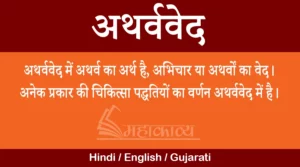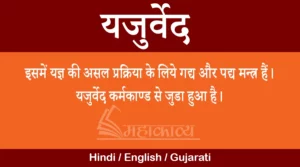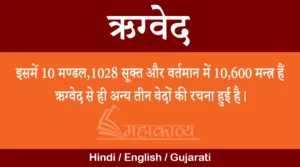Read Sam Veda in English
The oldest religious texts of Indian culture are the Vedas, which are divided into four parts, the Rigveda, the Yajurveda, the Samaveda, and the Atharvaveda. In the Vedas of this wonderful knowledge fund, the place of Sam veda (Sam Veda in English) comes in the third order. There are a total of 1875 musical mantras in Samveda, out of which 1504 mantras are taken from Rigveda. Apart from 99 mantras in Samveda, all the mantras are found in Rigveda only.
Read here in one click ~ Samveda in Hindi
Table of Contents
ToggleThere are two parts of Samveda:-
1 Archik and
2 songs
Meaning of Samveda: –
Samaveda (Sam Veda in English) is one of the famous four Vedas of Hinduism. The word ‘Sama’ means ‘song’, and Samaveda means song, because the main songs in it are music. The Samaveda contains mantras to be sung in Yagya, rituals, and Havan. The deities were praised by sages and sages by singing the Samaveda with music. Presently in Samveda, 13 branches are known by looking at Prapancha Hridaya, Divyavadana, Charanvyuh, and Jaimini Grihasutra. Out of these 13 friends, 3 friends are found which are given below.
There are three Acharyas in Samaveda:-
1 Kauthumiya,
2 Gemini and
3 explainable
The chief deity of the Samaveda (Sam Veda in English) is the Sun God. In this, there are mantras of praise of the main Sun God, but Indra Som is also described adequately in it. Samaveda has made an important contribution to the history of Indian music. Samveda is said to be the original form of Indian music. The first seer of Samveda is considered to be Jaimini, the disciple of Vedvyas.
Samveda is prominent in song music. The hymns of the Samaveda were sung by the ancient Aryans. Samveda is the smallest of all the four Vedas. Out of 1875 mantras of Samaveda, all except 99 are from Rigveda, and only 17 mantras are found from Atharvaveda and Yajurveda. Even then the prestige of Samveda is more than all.
Importance of Samveda: –
Importance of Samveda It is said in Bhagavad Gita that Vedanam Samvedosmi. Apart from this, the importance of Samaveda is also described in the discipline festival of Mahabharata that Samavedascha Vedanan Yajushan Shatrudriyam. By chanting the mantras of Samveda methodically in Agnipuran, man becomes free from diseases and pain, and his wishes are fulfilled. The method of singing the mantras of Samveda has been developed by the sages. Scholars have also accepted the fact that all the voices, talas, rhythms, verses, dance postures, expressions, etc. are part of Samveda only.
Best facts about Samveda:-
Samveda means that book whose mantras can be sung, and which are also musical.
Mantras are sung at the time of Yagya, Anushthan and Havan, in this there is a compilation of useful mantras of the Ugatri class of Yagyanushthan.
It is named Samaveda because it has only fixed mantras of the singing method.
In Samveda, most of its mantras are available in Rigveda, some mantras are also independent. The Samaveda originally contained 75 mantras, and the rest were taken from the Rigveda.
The greatness of the Vedas, the singers who were called Sama Gana. He has mentioned the use of only three voices in Vedagan which are called Udatta, Anudatta, and Svarit.
The music was practical music. Its details are not available.
Many types of musical instruments are mentioned in the Vedic period, among which Kannada Veena, Karkari, and Veena are among string instruments, Dundubhi, Aadambara, Vanaspati under Ghan instruments and Turab, Nadi and Bankura, etc. under Sushir instruments are particularly noteworthy.
music notes:-
The description of the singing method of Samveda is found in Naradiya Shiksha Granth, which is known as Sa-Re-Ga-Ma-Pa-Dha-Ni-Sa in the order of notes in modern Indian and Carnatic music.
hexadecimal
Rishabh – Ray
Gandhara – Ga
Medium – M
Pancham – P
dhaivat – dha
Nishad – Ni
षडज् – सा
ऋषभ – रे
गांधार – गा
मध्यम – म
पंचम – प
धैवत – ध
निषाद – नि
legacy:-
Branch- 1001 branches of Samveda are found in Vedas which is more than Rigveda, Yajurveda, and Atharvaveda. Different interpretations of mantras, ways of singing, and order of mantras are found in 1001 Sakhas of Samveda. These Indian scholars consider it a part of the same Vedrashi, Western scholars consider it a later text. But the mention of Samaveda is also found in Rigveda, which has the first place in Indian culture and western people know it by the name of Purana Veda. Samagan or Sama has been discussed at 31 places in Rigveda. Which by the names of Vairupam, Brihatam, Gauraviti, Revatan, Arke, etc. In Yajurveda, Samagan has been known by the names Rathantram, Brihatm, etc. Apart from this, Brihat, Rathantram, Vairupam, Vairajam, etc. are also discussed in Aitareya Brahmin.
Brahmin texts: –
As it had 1001 branches, there should be the same number of Brahmin texts, but only about 10 branches are available – Tandya. Shatvinsh etc. Chandogya Upanishad is the Upanishad of this Veda – which is also called the biggest Upanishad.
read this also
Please wait while flipbook is loading. For more related info, FAQs and issues please refer to DearFlip WordPress Flipbook Plugin Help documentation.





 Download the Mahakavya App
Download the Mahakavya App